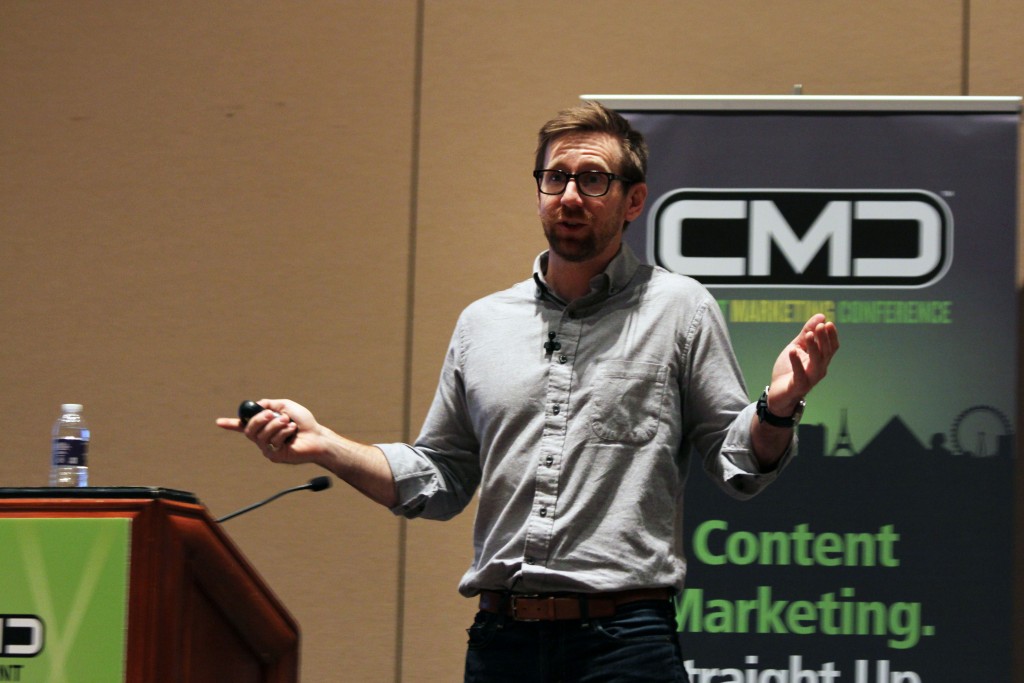You might not instantly recognize the name Mathew Sweezey, but if you’ve ever spent much time perusing the virtual pages of leading publications such as Forbes, CMO.com, Mashable, or VentureBeat, you’ve likely encountered Sweezey’s work. He’s a marketing dynamo, known as much for his research as he is from the forward-thinking, actionable solutions that data inspires.
At the 2016 Content Marketing Conference, Sweezey brought considerable knowledge to bear on the topic of content marketing. Specifically, in an age where we’re inundated with a constant barrage of content in every conceivable form, what’s next?
How We Learn
In 1960, there were only five marketing channels to contend with. Today, there are over 200, and more people have access to mobile phones than they do electricity or clean drinking water. Visit Facebook and you’ll run into a wall of some 1,500 posts waiting for your attention, and despite visiting the ‘Book some 17 times per day, you never quite catch up. Consumers now create more content than businesses do, and we did it all on our own.
It’s all about heuristic experiences, or enabling a person to learn for themselves. Sweezey uses email to make his point: the majority of people scan their inbox and delete everything irrelevant before concentrating on the leftovers, aka everything that is relevant. No one taught us this, we learned independently.
We’re also what Sweezey refers to as “batch researchers” – I might call it “information hoarding.” We keep our inboxes full of emails we’ll look at later and we download ebooks we promise ourselves we’re going to read.
All this adds up to an excess of content with a marked lack of actual connection. No wonder we’re not converting, right?
Facilitate the Act of Discovery
More than 70 percent of the content we create goes unutilized, which just goes to show that there’s plenty of content out there, consumers just aren’t finding it.
There are two kinds of discovery:
- Active – People are looking for something specific. They’re searching for directions on how to work their DVR, they’re hunting for the best route is between Ft. Lauderdale and New Orleans, or they’re wondering how to cook chicken cassoulet.
- Passive – Passive content is the stuff people find when they’re looking but not for anything in particular. It’s the posts people run across while scrolling through their Twitter feed or while surfing a news site.
Both types of content are important, but passive has more power. Why? Because of self-discovery. If you tell someone your company is the best or that gorillas only eat cauliflower or that the moon is made of fat-free cheese, they’re going to be suspicious, because people are naturally suspicious of other people’s motives. Obviously you’d benefit from my believing in your company’s superiority, the gorilla story might be cover for your investment in a new cauliflower farm, and as for the cheesy moon, maybe you just want to laugh at me.
On the other hand, passive content – content I find myself – holds water. Self-discovery equals trust. Brands can use this trust as a springboard by encouraging consumers to discover the content deemed most important by the brand. The best example of this is Amazon’s “if you like this…” feature. They sell more products because someone who was interested in toothpaste is also shown a toothbrush. Push the tooth brush and you put consumers on the offensive; let them find the toothbrush (hidden in plain sight, so to speak) themselves, and you may just have a sale.
Swap the What for the Why
Everyone in the industry loves metrics because numbers give us the feeling that we can quantify our success. How many people have looked at our new website? What was the click-through rate on that latest Facebook ad? How many retweets did our latest post get? A couple hundred likes can quickly have us feeling the love, but what do they really mean?
According to Sweezey, not much. When someone downloads your ebook, it doesn’t mean that the ebook is good, it just means someone thought it might be. Same goes for shares and likes. People often don’t even read the content they react to, so what good are those metrics anyway? And more importantly, what’s the alternative?
Ask for reviews. Post a poll, send out a survey, use SMS to beg for feedback. Whatever your method, ask your audience the following:
- What were you looking for?
- Did you find it?
- How can we make this better?
Get the answers from the people who matter and the data you gather will matter too.
Nobody Says “I Want Content”
People don’t crave content, they crave solutions. They want to live better, have more fun, achieve more success, be happier, get healthier. As Sweezey says, people engage with content “because it aligns with their purpose.” Create content that delivers on its promise and you’ll win a fan; fail in that promise and you’ve broken trust. Some 71 percent of B2B buyers say they’ve been disappointed by a brand’s content and 25 percent say they wouldn’t engage with that brand again.
How can you avoid swinging and missing?
- Create content that matters to consumers
- Put it where they can find it
- Ask them whether you’re doing it right
- Deliver on the content you promised
- Nurture the relationships you’ve already built
Mathew Sweezey’s presentation was a semester-long class stuffed into an hour-long session, so if this blog seems condensed, it’s because it is. The ideas, though, are as big and bold as ever, and the overarching takeaway remains the same: content marketing is changing as quickly as society is. If we fail to evolve, consumers won’t hesitate to leave us behind.

